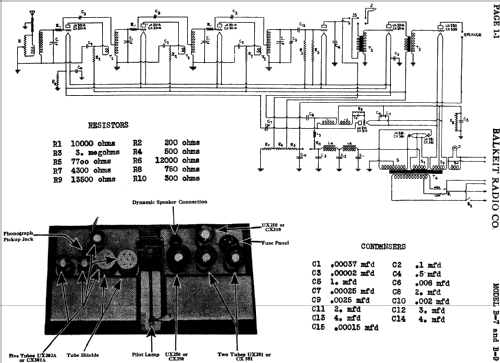Balkeit Symphion B7
Fansteel Products (Pfanstiehl, Pfansteihl, Balkite, Balkeit); Chicago
- Country
- United States of America (USA)
- Manufacturer / Brand
- Fansteel Products (Pfanstiehl, Pfansteihl, Balkite, Balkeit); Chicago
- Year
- 1928
- Category
- Broadcast Receiver - or past WW2 Tuner
- Radiomuseum.org ID
- 33973
-
- alternative name: Balkeit || First National
- Brand: Overtone
Click on the schematic thumbnail to request the schematic as a free document.
- Number of Tubes
- 9
- Main principle
- TRF without regeneration; Neutrodyne
- Tuned circuits
- 4 AM circuit(s)
- Wave bands
- Broadcast only (MW).
- Power type and voltage
- Alternating Current supply (AC) / 115 Volt
- Loudspeaker
- -Loudspeaker incorporated, but system not known.
- Material
- Wooden case
- from Radiomuseum.org
- Model: Balkeit Symphion B7 - Fansteel Products Pfanstiehl,
- Shape
- Console with any shape - in general
- Notes
- Balkeit, Balkite, Pfanstiehl are put together to Fansteel. One dial (primary tuning control knob).
The Symphion models employ a UX210 tube as an oscillator at about 3000 kHz, to supply the filaments of the five 201As ! Thus avoiding hum and permitting use of the 201A (which is considered superior) in an electric set.
- Price in first year of sale
- 475.00 $
- External source of data
- Ernst Erb
- Source of data
- Radio Collector`s Guide 1921-1932
- Circuit diagram reference
- Rider's Perpetual, Volume 1 = 1931/1934 (for 1919-1931)
- Mentioned in
- Collector's Guide to Antique Radios 4. Edition
- Literature/Schematics (1)
- Radio Manufacturers of the 1920's, Vol. 2
- Other Models
-
Here you find 131 models, 74 with images and 61 with schematics for wireless sets etc. In French: TSF for Télégraphie sans fil.
All listed radios etc. from Fansteel Products (Pfanstiehl, Pfansteihl, Balkite, Balkeit); Chicago
Forum contributions about this model: Fansteel Products: Balkeit Symphion B7
Threads: 1 | Posts: 1
Um einerseits die direkt geheizten Trioden UX201A ohne Netzbrumm verwenden zu können, kam man hier (und auch beim Modell B9) auf die Idee, mit Hochfrequenz zu heizen. Vorteil: das Gerät ist sofort betriebsbereit, und der Wiedergabe-Frequenzbereich ließ sich ausweiten, vor allem nach unten..
Als Frequenz wurde etwa 3 MHz gewählt, somit weit über dem Rundfunkband gelegen. Eine rückgekoppelte UX210A die bei 12 W maximaler Anodenverlustleistung normalerweise nur 1,6 W Sprechleistung bringt, macht voll durchgesteuert (Klirrfaktor ist egal) gerade schön die erforderlichen 6,25 W für die fünf UX201A (je 5V / 0,25 A).
Diese Neutrodyne-Vierkreiser waren bald überholt durch bessere Röhren mit indirekter Heizung, durch Schirmgitterröhren und schließlich durch die aufkommenden Superhets.
Konrad Birkner † 12.08.2014, 07.Sep.09
